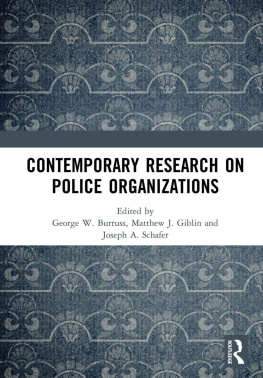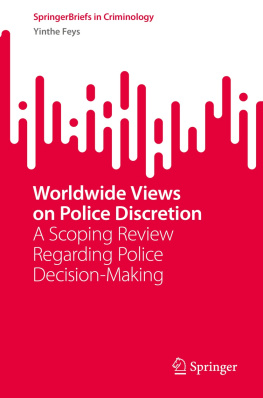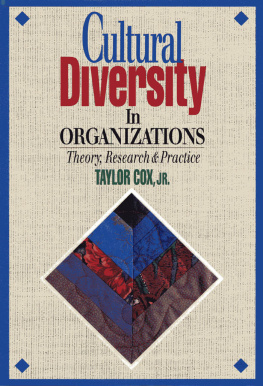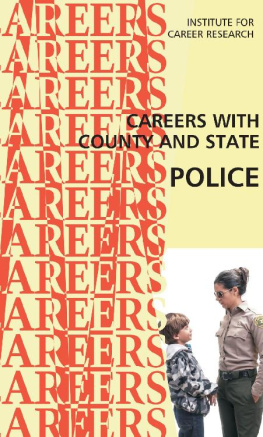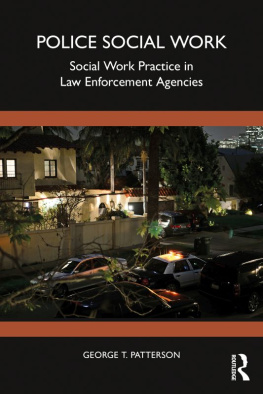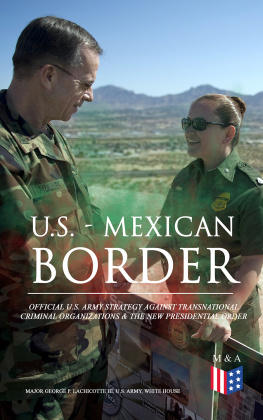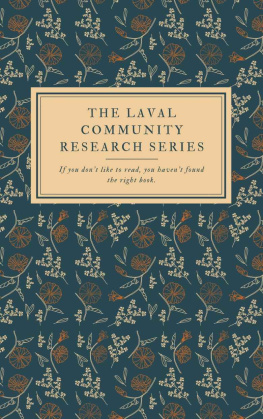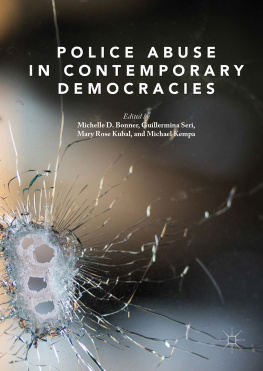Contemporary Research on Police Organizations
Much research on policing focuses on individual officer decision making in the field, but officers are positioned within organizations. Organizational characteristics, including structures, policies, management, training, culture, traditions, and the environmental context affect individual officer behavior and attitudes. Recent high-profile controversies surrounding policing have generated interest in examining what factors may have led to current crises.
In this book, contributors discuss how police department priorities are made; how departments respond to sexual assault complaints; how forensic scientists deal with job stress and satisfaction; how police use gun crime incident reviews for problem solving and information sharing; how police officers view the use of body-worn cameras given their perceptions of organizational justice; and how officers view their work culture. The purpose of this book is to give policy makers and scholars some guidance on the interplay between the individual and the organization. By understanding this dynamic, police administrators should be able to better devise reform efforts.
This book was originally published as a special issue of the Journal of Crime and Justice.
George W. Burruss is an associate professor in the Department of Criminology at the University of South Florida and the Florida Center for Cybersecurity, USA.
Matthew J. Giblin is professor in the Department of Criminology and Criminal Justice at Southern Illinois University, Carbondale, USA.
Joseph A. Schafer is professor in the Department of Criminology and Criminal Justice at Southern Illinois University, Carbondale, USA.
Contemporary Research on Police Organizations
Edited by
George W. Burruss, Matthew J. Giblin and Joseph A. Schafer
First published 2018
by Routledge
2 Park Square, Milton Park, Abingdon, Oxon, OX14 4RN, UK
and by Routledge
711 Third Avenue, New York, NY 10017, USA
Routledge is an imprint of the Taylor & Francis Group, an informa business
2018 Midwestern Criminal Justice Association
All rights reserved. No part of this book may be reprinted or reproduced or utilised in any form or by any electronic, mechanical, or other means, now known or hereafter invented, including photocopying and recording, or in any information storage or retrieval system, without permission in writing from the publishers.
Trademark notice: Product or corporate names may be trademarks or registered trademarks, and are used only for identification and explanation without intent to infringe.
British Library Cataloguing in Publication Data
A catalogue record for this book is available from the British Library
ISBN 13: 978-1-138-49402-2
Typeset in Myriad Pro
by RefineCatch Limited, Bungay, Suffolk
Publishers Note
The publisher accepts responsibility for any inconsistencies that may have arisen during the conversion of this book from journal articles to book chapters, namely the possible inclusion of journal terminology.
Disclaimer
Every effort has been made to contact copyright holders for their permission to reprint material in this book. The publishers would be grateful to hear from any copyright holder who is not here acknowledged and will undertake to rectify any errors or omissions in future editions of this book.
Contents
Citation Information
The chapters in this book were originally published in the Journal of Crime and Justice, volume 40, issue 1 (March 2017). When citing this material, please use the original page numbering for each article, as follows:
Editorial
Introduction to the special issue on police organizations
George W. Burruss, Matthew J. Giblin and Joseph A. Schafer
Journal of Crime and Justice, volume 40, issue 1 (March 2017), pp. 14
Chapter 1
How perceptions of the institutional environment shape organizational priorities: findings from a survey of police chiefs
Matthew C. Matusiak, William R. King and Edward R. Maguire
Journal of Crime and Justice, volume 40, issue 1 (March 2017), pp. 519
Chapter 2
Active representation and police response to sexual assault complaints
Melissa Schaefer Morabito, April Pattavina and Linda M. Williams
Journal of Crime and Justice, volume 40, issue 1 (March 2017), pp. 2033
Chapter 3
Examining the impact of organizational and individual characteristics on forensic scientists job stress and satisfaction
Thomas J. Holt, Kristie R. Blevins and Ruth Waddell Smith
Journal of Crime and Justice, volume 40, issue 1 (March 2017), pp. 3449
Chapter 4
Gun crime incident reviews as a strategy for enhancing problem solving and information sharing
Natalie Kroovand Hipple, Edmund F. McGarrell, Mallory OBrien and Beth M. Huebner
Journal of Crime and Justice, volume 40, issue 1 (March 2017), pp. 5067
Chapter 5
The impact of law enforcement officer perceptions of organizational justice on their attitudes regarding body-worn cameras
Michael J. Kyle and David R. White
Journal of Crime and Justice, volume 40, issue 1 (March 2017), pp. 6883
Chapter 6
Understanding the culture of craft: lessons from two police agencies
James J. Willis and Stephen D. Mastrofski
Journal of Crime and Justice, volume 40, issue 1 (March 2017), pp. 84100
For any permission-related enquiries please visit: http://www.tandfonline.com/page/help/permissions
Notes on Contributors
Kristie R. Blevins is associate professor in the School of Justice Studies at Eastern Kentucky University, USA.
George W. Burruss is associate professor in the Department of Criminology at the University of South Florida and the Florida Center for Cybersecurity, USA.
Matthew J. Giblin is professor in the Department of Criminology and Criminal Justice at Southern Illinois University, Carbondale, USA.
Natalie Kroovand Hipple is assistant professor in the Department of Criminal Justice at Indiana University, USA.
Thomas J. Holt is professor in the School of Criminal Justice at Michigan State University, USA.
Beth M. Huebner is professor and graduate director in the Department of Criminology and Criminal Justice at the University of Missouri St Louis, USA.
William R. King is professor and associate dean of Research in the College of Criminal Justice at Sam Houston State University, USA.
Michael J. Kyle is a PhD candidate in the Department of Criminology and Criminal Justice at Southern Illinois University, Carbondale, USA.
Edward R. Maguire is professor in the School of Criminology and Criminal Justice at Arizona State University, USA.
Stephen D. Mastrofski is professor in the Department of Criminology, Law and Society and director of the Center for Justice Leadership and Management at George Mason University, USA.
Matthew C. Matusiak is assistant professor in the Department of Criminal Justice at the University of Central Florida, Orlando, USA.
Edmund F. McGarrell


